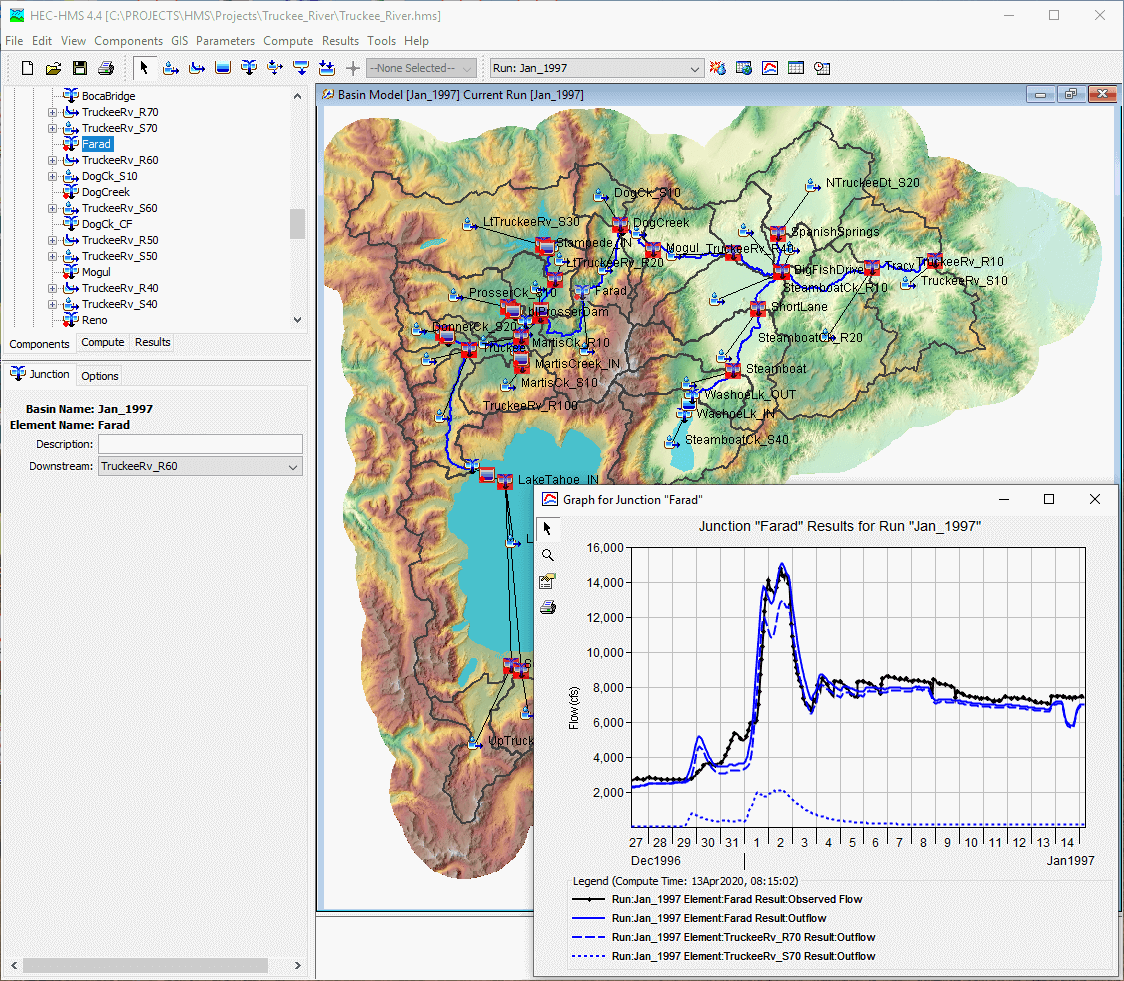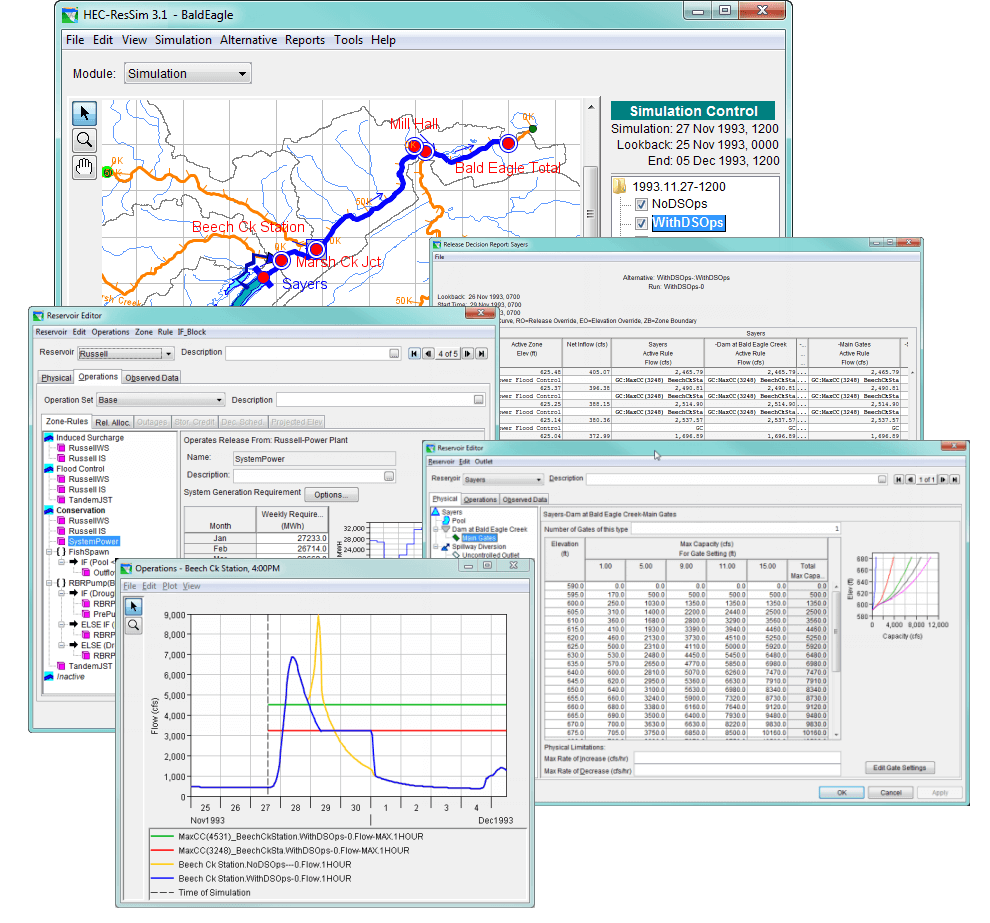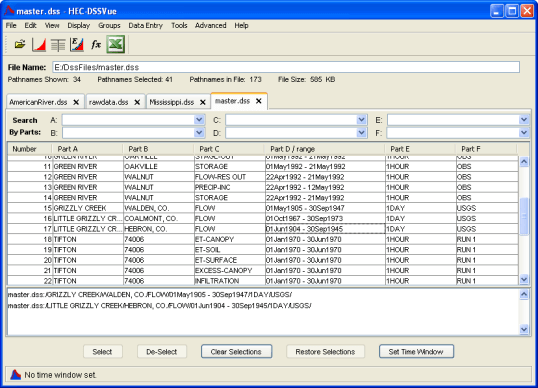- Hec Hms software, free download. software
- Hec Hms 4.2.1 Download
- Hec Hms software, free download Windows 7
However, it looks like you can no longer download the old 'legacy software' (HEC-1, HEC-2, etc.) at the USACE's HEC web site. Might any of you know an alternative site that has a free HEC-1 download? My googling got me to the old Dodson-Hydro site, but I can't get to where the 'free downloads' are located (even after 'registering'). I feel like I'm the first person to crack this HEC-HMS XSL Style Sheet nut. In any case I'm the first one to share it on the web. First of all, before diving into how to get a report using a Style Sheet, you should realize that a sort of basin model report from HEC-HMS is available as a readable text file in the.basin file.
First of all, before diving into how to get a report using a Style Sheet, you should realize that a sort of basin model report from HEC-HMS is available as a readable text file in the .basin file. But beyond that, for the purposes and in the hope that we users would develop tabular reports, the HEC also provided a report definition language (that they didn't document very well) for reports we can get from the Tools, Reports menu.I was able to create an SCS Basin Summary style sheet by using the 'tags' in the .basin file, making them lower case and removing spaces from them. Here's an example of how I added the Curve Number to my report:
1. The sample Snyder report provided by the HEC includes this snippet
2. My .basin file includes this snippet
3. I turned 'Curve Number' from step 2 into curvenumber below. I continued that way to use the example of the .basin file and correct (with some oddities) the table HTML to create an SCS Basin table as shown below:
And here is the complete file I saved as SCSBasinSummary.xsl
And here is the resulting report :-) :
Basin Model 'Bisbee Tailing 071609'
| Subbasin | Area | SCS CN | SCS Lag |
|---|---|---|---|
| SCTSA Top Basin | 0.2149 | 87 | 17.7 |
| SCTSA Top Pond 1 | 0.1548 | 87 | 24.1 |
| SCTSA Top Pond 2 | 0.1345 | 87 | 28.8 |
| SCTSA Top Pond 3 | 0.0877 | 87 | 24.7 |
| SCTSA TOE-1 | 0.0895 | 87 | 9.4 |
| W Natural Ground 1 | 0.0831 | 87 | 11.7 |
| SCTSA Main 2 WS | 0.01259 | 87 | 11.0 |
| SCTSA-W3 | 0.0079 | 87 | 3.2 |
| SCTSA-W1 | 0.0073 | 87 | 3.2 |
| SCTSA Main 3 WS | 0.0327 | 87 | 8.7 |
| HR 1 | 0.0168 | 87 | 1.5 |
| SCTSA-S3 | 0.0135 | 87 | 4.3 |
| SCTSA-S4 | 0.0125 | 87 | 4.1 |
| SCTSA-S2 | 0.0058 | 87 | 2.6 |
| SCTSA-S1 | 0.0053 | 87 | 2.3 |
| SCTSA-S5 | 0.0166 | 87 | 4.8 |
| SCTSA-S6 | 0.0132 | 87 | 3.2 |
| SCTSA-S7 | 0.0168 | 87 | 6.1 |
| HP-1 | 0.047 | 87 | 6.3 |
| SCTSA-S8 | 0.0217 | 87 | 5.3 |
| Upstream Natuural | 0.6291 | 87 | 15.3 |
| NCTSA Top | 0.2581 | 87 | 18 |
| NCTSA-E3 | 0.0289 | 87 | 5.3 |
| NCTSA-E5 | 0.0083 | 87 | 3.6 |
| NCTSA-E2 | 0.0050 | 87 | 3.8 |
| NCTSA-E1 | 0.0033 | 87 | 2.2 |
| NCTSA-E4 | 0.0022 | 87 | 2.9 |
| SCTSA-E3 | 0.0108 | 87 | 6.5 |
| NCTSA Main 4 WS | 0.0055 | 87 | 2.5 |
| NCTSA Main 5 WS | 0.0162 | 87 | 2.9 |
| SCTSA-E2 | 0.0123 | 87 | 5.7 |
| NCTSA Main 6 WS | 0.0097 | 87 | 4.2 |
| SCTSA-E1 | 0.0060 | 87 | 4.5 |
| NCTSA Main 7 WS | 0.0075 | 87 | 2 |
| SCTSA-E0 | 0.0022 | 87 | 2.9 |
| NCTSA Main 8 WS | 0.0057 | 87 | 1.9 |
| HR-2 | 0.0097 | 87 | 1.5 |
| HP-2 | 0.0475 | 87 | 3.9 |
| SCTSA-E4 | 0.0070 | 87 | 1.6 |
Here's another one that reports both SCS and Green-Ampt and Clark:
<table border='2' width='100%'>
<tr>
<th></th>
<th>Subbasin</th>
<th>Area</th>
<th>SCS CN</th>
<th>SCS Lag</th>

<th>GA IC</th>
<th>GA SC</th>
<th>GA Suction</th>
<th>GA Conduct.</th>
<th>GA %Imp.</th>
<th>Clark TC</th>
<th>Clark R</th>
</tr>
 <xsl:for-each select='/HMS:basin/HMS:subbasin'>
<xsl:for-each select='/HMS:basin/HMS:subbasin'><tr>
<td><xsl:apply-templates select='.'/></td>
<td><xsl:apply-templates select='./HMS:area'/></td>
Hec Hms software, free download. software
<td><xsl:apply-templates select='./HMS:lossrate/HMS:curvenumber'/></td><td><xsl:apply-templates select='./HMS:transform/HMS:lag'/></td>
<td><xsl:apply-templates select='./HMS:lossrate/HMS:initialcontent'/></td>
<td><xsl:apply-templates select='./HMS:lossrate/HMS:saturatedcontent'/></td>
<td><xsl:apply-templates select='./HMS:lossrate/HMS:wettingfrontsuction'/></td>
<td><xsl:apply-templates select='./HMS:lossrate/HMS:hydraulicconductivity'/></td>
<td><xsl:apply-templates select='./HMS:lossrate/HMS:percentimpervious area'/></td>
<td><xsl:apply-templates select='./HMS:transform/HMS:timeofconcentration'/></td>
<td><xsl:apply-templates select='./HMS:transform/HMS:storagecoefficient'/></td>
</tr>
</xsl:for-each>
</table>
Click on the underlined text to go directly to a specific software description or scroll down to read the document in its entirety.
- ESFFAN (Engsoft Flood Frequency Analysis )
- ESLOFFAN (Engsoft Low Flow Frequency Analysis )
- FO601 with Retard
- HEC-FFA (Floodflow Frequency Analysis)
- HEC-HMS ( Hydrological Modelling System)
- HFAM ( Hydrocomp Forecast and Analysis Modeling )
- Hydraflow Hydrographs version 6
- HYSIM ( Hydrological Simulation Model)
- MIDUSS Version 2 ( Microcomputer Interactive Design of Urban Stormwater Systems)
- MLRP (Multiple linear Regression program)
- PC IHACRES (Identification of unit Hydrographs And Component flows from Rainfall, Evaporation and Streamflow data)
- PLOTHYD version 1.3 for Windows
- SMADA for Windows
- Streamflow Toolkit 2.0
- SWMHYMO version 4.02
- TR-55, Urban Hydrology for Small Watersheds version 2.0
- Visual OTTHYMO version 2.0
- WMS ( Watershed Modeling System )
Add your software to the list.
ANNIE
ANNIE is a program designed to help users interactively store, retrieve, list, plot, check, and update spatial, parametric, and time-series data for hydrologic models and analyses. Data are stored in a direct access file called a Watershed Data Management (WDM) file. Many hydrologic and water-quality models and analyses developed by the U.S. Geological Survey (USGS) and the Environmental Protection Agency (EPA) currently use WDM files. The WDM file provides users with a common data base for many applications, thus eliminating the need to reformat data from one application to another. There is also an expanding library of subroutines for graphics, user interaction, and data storage and retrieval available to application programmers designing software utilizing WDM files.
DCUH
Provides an estimation of a unit graph from rainfall and discharge data. The method uses Snyder's Least Squares algorithm coupled with the author's modified smoothing method.
ESFFAN (Engsoft Flood Frequency Analysis)
This program is a preprocessor for generating 1 to 12 annual flood flow series from daily flows available from standard data bases such as HYDAT or USGS. Alternatively flood flows can be entered manually. Gumbel, Log Pearson Type 3, or 3-Parameter Log Normal Distribution are available (more distributions available optionally). Results graphically presented. The program is fully MS-Windows 3.1 and MS-Windows 95 based with menus and push buttons for easy user-program interface
ESLOFFAN (Engsoft Low Flow Frequency Analysis)
This program is a preprocessor for generating 7-day or 30-day average flow series from daily flows available from standard data bases such as HYDAT or USGS. Alternatively the user can enter low flows manually. Gumbel, Log Pearson Type 3, 2 or 3-Parameter Log Normal distributions are available. Results are graphically presented. The program is fully MS-Windows 3.1 and MS-Windows 95 based with menus and push buttons for easy user-program interface
FO601 with Retard
Modified Rational Method. Built-in Volume Calculations, Automatic Soil 'C' adjustment using Burn Factor if desired. Use of sub-areas small than one acre. User Friendly Data Input.
Hec Hms 4.2.1 Download
FREQ
FREQ is least squares estimation program for LP3 flood frequency estimation. The program provides the calculation of unbiased frequency factors and confidence limits for estimates.
HEC-1
US Army Corps of Engineers Flood Hydrograph Package for rainfall-runoff simulations. This program will produce runoff hydrographs for complex watershed networks using unit hydrograph or kinematic wave methods and incorporating reservoir and channel routing procedures. The program will allow various methods for calculating rainfall hyetographs, basin unit hydrographs and watershed loss rates. HEC-HMS will eventually replace this program.
HEC1Time
This program will take a cumulative rainfall total and distribute it incrementally over a set storm time period. It will distribute rainfall over SCS Type I, II, or III storm patterns or a user specified pattern. The output is a HEC-1 input ready table of incremental rainfall depths.
HEC-FFA (Floodflow Frequency Analysis)
This US Army Corps of Engineers program performs frequency computations of annual maximum flood peaks in accordance with the Water Resources Council 'Guidelines for Determining Flood Flow Frequency' Bulletin 17B
HEC-HMS (Hydrological Modelling System)
The HEC-HMS is designed to simulate the rainfall-runoff process of dendritic watershed systems. It is designed to be applicable in a wide range of geographic areas for solving the widest possible range of problems. The program features a completely integrated work environment including a database, data entry utilities, computation engine and results reporting tools. A graphical user interface allows the user seamless movement between the different parts of the program.
HFAM (Hydrocomp Forecast and Analysis Modeling)
HFAM combines hydrologic simulation and data management with an interactive graphical interface to provide a tool for streamflow forecasting and log-term analysis of streamflow, reservoir operations, and watershed development. A variety of screens show the model setup and maps of the watershed area. Modeling results are viewed in graphical displays. The HFAM systems consist of a set of physically-based, continuous, deterministic models.
HSPF
HSPF is a continuous hydrologic model, which can be used to simulate a wide range of hydrologic and water quality processes. It incorporates the watershed-scale ARM and NPS models into a basin-scale analysis framework in one-dimensional stream channels. It is a comprehensive model of watershed hydrology and water quality that allows the integrated simulation of land and soil contaminant runoff processes with in-stream hydraulic and sediment-chemical interactions.
HYDAT CD-ROM 1998-1.05.8
This is a database system containing streamflows, water levels, and sediment data collected by Environment Canada and by provincial, municipal and private agencies throughout Canada.
HYDSTAT
HYDSTAT performs statistical analyses of hydrologic data. The program fits the input data (such as stream gage records) to four of the most commonly used hydrologic statistical distributions. The program performs a great deal of statistical analyses and has graphic capabilities.
Hydraflow Hydrographs version 6
This program determines surface runoff using SCS TR-20, Rational and SBUH methods with built-in SCS 24-hr storms or synthetic design storms based on IDF curves. It includes a built-in TR-55 Tc calculator with printed report. The program can combines hydrographs, divert hydrographs by constant Q, ratio, or to any pond structure. It will route hydrographs through channels using Modified Att-Kin, or through wet or dry detention ponds. It can compute outlet flows for detention ponds for up to 8 user-definable outlet structures per pond and can handle multi-stage outlet works. The program includes automatic batch run operation for multiple return periods. Storage values can be computed from contour areas, bottom area / side slope or a built-in pipe volume calculator. Pond Wizard completely designs detention ponds and their outlet structure.
HydroFreq version 1.0 (Hydrologic Flow Frequency Analysis)
This program calculates the flow values for specified return periods based on a statistical analysis of a series of annual extreme flow data.
HYSIM (Hydrological Simulation Model)
HYSIM is a hydrological simulation model (rainfall runoff model ) which uses rainfall and potential evaporation data to simulate the hydrological cycle (surface runoff, percolation to groundwater and river flow) on a continuous basis
MIDUSS Version 2 (Microcomputer Interactive Design of Urban Stormwater Systems)
The MIDUSS Version 2 package was developed to help drainage engineers to design the hydraulic elements in a collection network of storm sewers or channels. The program allows the user to define a rainfall hyetograph (synthetic, design type or historic) and a single sub catchment. The program computes the total overland flow hydrograph and has the ability to design conveyance and storage elements in the drainage network including pipes, channels, ponds, diversions, and trenches.
MLRP (Multiple linear Regression program)
Major features of this program are automatic deletion of independent variables (according to importance), combination of variables to form new variables, transformation of variables, tabulation of the residuals form the prediction equation and acceptance of input coefficients.
PC IHACRES (Identification of unit Hydrographs And Component flows from Rainfall, Evaporation and Streamflow data)
PC-IHACRES uses a transfer function / unit hydrograph (UH) approach to catchment-scale (lumped) rainfall-runoff modelling, developed jointly by the Institute of Hydrology (now CEH) and the Centre for Resource and Environmental Studies at the Australian National University. PC-IHACRES applications include investigations in small catchments instrumented for special studies, regional studies using readily-available data for large catchments, and quality assurance of strategically-important streamflow and rainfall records.

PCSWMM 2000
This program is a decision support system for the US EPA's Stormwater Management Model (SWMM4). It utilizes the SWMM4 core processes and also provides a Geographic Information System (GIS) with optional links to existing GIS/AM/FM/CAD databases. The comprehensive PCSWMM 2000 can be used for solving problems ranging from small BMP installations to continuous hydrology, hydraulics and quality simulation of major/minor drainage systems.
PLOTHYD version 1.3 for Windows
With PLOTHYD the user can create and/or modify up to six hydrograph files at a time and produce consistent prints and plots of their data. The program provides statistics on the data to reduce error or evaluate data.
Rational Method Hydrology
Small Area Rainfall Run Off Programs. Interactive user input file for easy file entry. Built in hydraulics for subsequent design of structures.
SCSHYDRO
This program is a rainfall-runoff model based on U.S. Department of Agriculture Soil Conservation Service (SCS) hydrologic procedures. A modern replacement for TR-20.
SMADA for Windows
SMADA is a hydrology package which consists of a number of separate executable files. These programs work together to allow hydrograph generation, pond routing, storm sewer design, statistical distribution and regression analysis, pollutant loading modelling, matrix calculation and others.
STATS
This program can be used to reduce large volumes of time series data to a few meaningful statistics or curves. The program will perform the following analyses: Duration curves, annual maximum events, annual minimum events, departures of monthly and annual values from respective means and annual volume duration exchange of high and low events.
Hec Hms software, free download Windows 7
Streamflow Toolkit 2.0
This program gives users the ability to obtain various graphical presentations and statistical summaries of stream flow and water conditions at any gauging sites across Canada.
STORMS 2000
With STORMS 2000 the user can create design storms (Chicago, SCS, AES, Huff, or User defined), create a database of IDF curves, generate IDF curves using the GEV distribution, determine the return period of observed events, and plot storm data or IDF curves on report ready charts. The program includes a database of more than 1200 Canadian meteorological stations.
SWMHYMO version 4.02
SWMHYMO can use single rainfall events (observed or synthetic) or continuous rainfall records to simulate the transformation of rainfall into surface runoff. Computed hydrographs can be routed through pipes, channels or stormwater control ponds and reservoirs. In urban areas, the effective capture rates of catchbasins and the effects of surface storage in street low points can also simulated.
TOC
TOC computes overland time of concentration using a combination of the Kinematic Wave Formula and the Green & Ampt method. The technique was developed and published by Dr. Akan.
TR-20
This US SCS (Soil Conservation Service now the Natural Resources Conservation Service (NRCS)) computer program was formulated to develop runoff hydrographs, route hydrographs through both channel reaches and reservoirs, and combine or separated hydrographs at confluences.
TR-55, Urban Hydrology for Small Watersheds version 2.0
This US SCS (U.S. Soil Conservation Service now the Natural Resources Conservation Service (NRCS)) computer program was developed to calculate storm runoff volume, peak rate of discharge, hydrographs and storage volumes required for floodwater reservoirs. The procedures are applicable in small watersheds, especially urbanizing watersheds in the United States.

Unit Hydrograph Method
Large Area Rainfall Run Off Software. Rainfall isohyetal data and the soil, development types (pervious ratio) are automatically area averaged for soil antecedent moisture conditions- required for most counties. Flood Hydrograph and Volume Calculations output. Export to ROUTE program for HEC-1.
Visual OTTHYMO version 2.0
Visual OTTHYMO version 2.0 (VO2) is a single event hydrologic model used to simulate hydrographs by modelling rainfall, infiltration, runoff and routing through a watershed. The hydrographs generated are based on unit hydrograph theory and can be used for uncalibrated or calibrated modelling studies. The model is an appropriate design tool for use in projects such as watershed studies and stormwater management design.
WMS (Watershed Modeling System)
WMS is a comprehensive environment for hydrologic analysis. It is developed by the Environmental Modeling Research Laboratory of Brigham Young University in cooperation with the U.S. Army Corps of Engineers Waterways Experiment Station (USACE-WES). WMS merges information obtained from terrain models and GIS with industry standard lumped parameter hydrologic analysis models such as HEC-1 and TR-20. Terrain models can obtain geometric attributes such as area, slope and runoff distances. Many display options are provided to aid in modeling and understanding the drainage characteristics of terrain surfaces.
